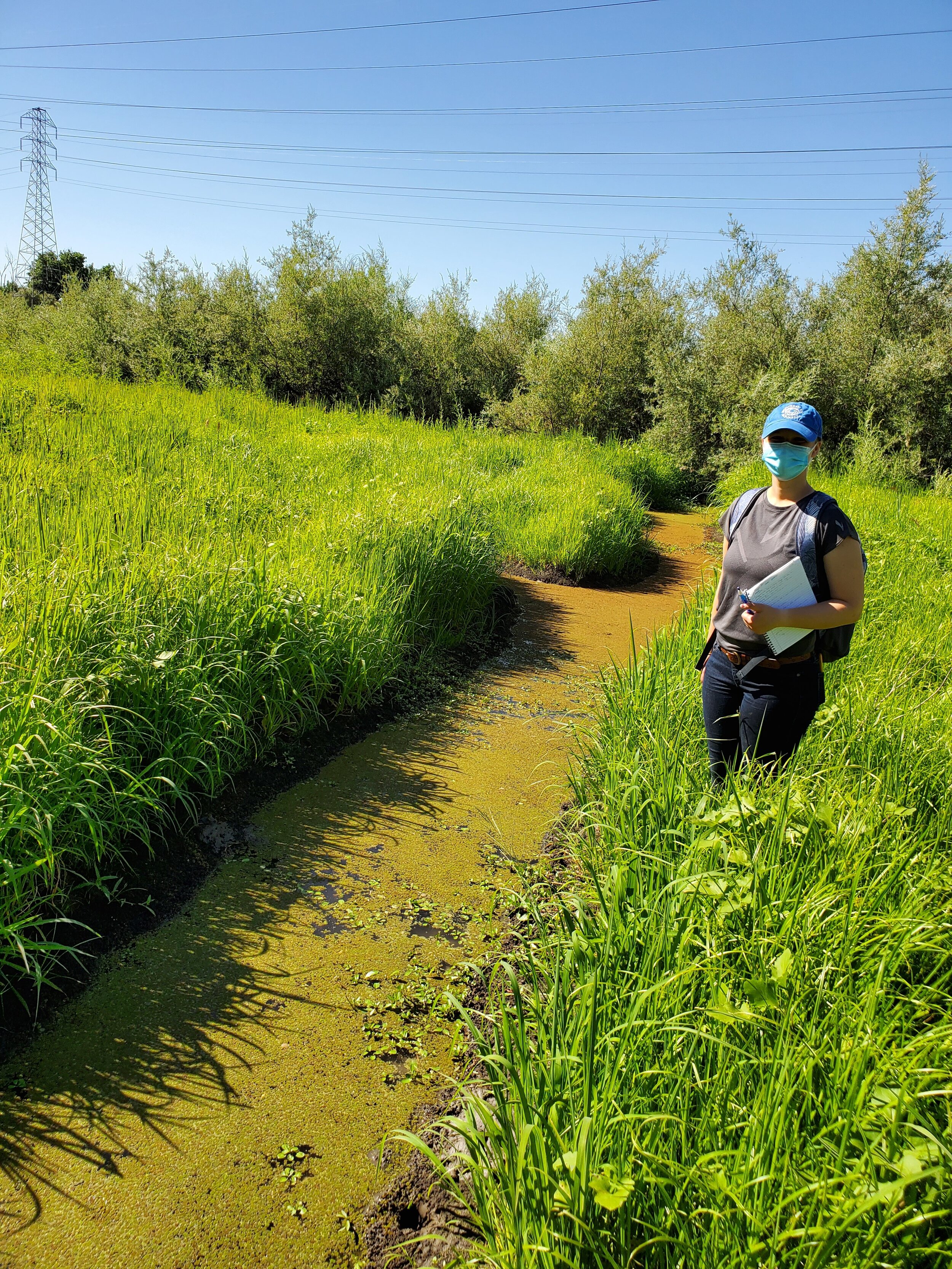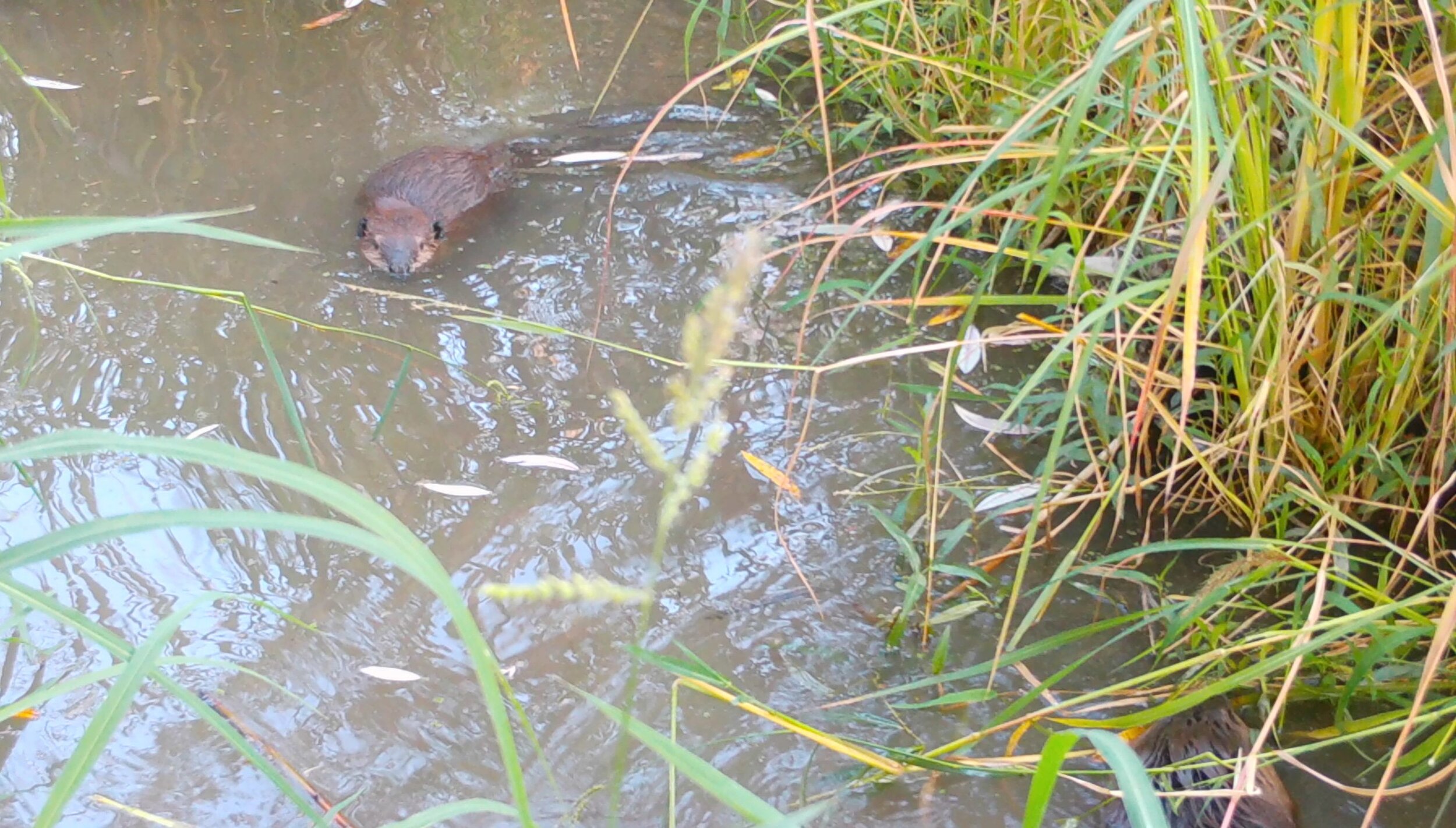
Beavers at Bushy Lake
Beavers were first discovered at Bushy Lake in 2019. They are a keystone species and an ecosystem engineer. Evidence of beavers at Bushy Lake includes the felling of trees, two lodges, canals or “beaveways,” an upcoming beaver dam, and visual encounters. A single beaver has been observed at a time, however based on the large-sized lodges with freshly cut vegetation, it is hypothesized that a colony resides at Bushy Lake.

Beavers construct dams from woody vegetation, sediments, rocks, and sticks.

There are several beaver-made canals throughout the Southern portion of Bushy Lake; we have referred to these as “beaveways.” Beavers create these canals by pushing vegetation, mud, and any debris to the sides to extend the water system.

Beavers were first discovered at Bushy Lake in 2019. They are a keystone species and an ecosystem engineer.
Tree Felling
Beavers cut down, or fell, trees to use as a food source and as a building material. Beavers are herbivores that primarily consume the inner bark of woody vegetation (Lundquist & Dolman, 2018). Several felled trees have been observed on the eastern and northern sides of Bushy Lake. This is significant for increasing vegetation biodiversity through allowing greater abundance of understory species, promoting straighter and taller vegetation growth, and attracting insects for avian prey (Naiman, et al., 1988; Wright, et al., 2002; Longcore & Müller-Schwarze, 2007).
Pictured at right: A felled tree
Lodges
There are two large beaver lodges located on the southern edge of Bushy Lake. Both structures featured freshly cut vegetation in March of 2021, showcasing their continued usage. Lodges and dens serve as a refuge to protect beavers from predators and often include an underwater entrance for easy access (Naiman, et al., 1998). Turtles can utilize the lodges for basking in the sun or for protection from submerged vegetation beneath the water (Metts, et al., 2001).
Canals or “Beaveways”
There are several beaver-made canals throughout the Southern portion of Bushy Lake; we have referred to these as “beaveways.” Beavers create these canals by pushing vegetation, mud, and any debris to the sides to extend the water system. These structures allow for easier mobility and improved access to vegetation for beavers. It is hypothesized that beaverways improve mobility for turtles as well. Access to the uplands is crucial for turtle nesting. In June of 2020 and April of 2021, two female red-eared sliders were observed near the beaveways, heading towards a canal. The rear ends of their shells appeared wet and muddy, indicating a nesting attempt. Additionally, a comparison study of turtles in back channels versus the mainstream channel in a habitat unmodified by beavers found that turtle richness and abundance was significantly higher in the back channels (Zadnik, 2003). It is hypothesized that beaver-made channels at Bushy Lake would have similar results.
Dams
Beavers construct dams from woody vegetation, sediments, rocks, and sticks. Dams retain water, creating gentle and slow-moving pools, expanding wetted areas, improving resource accessibility, and providing protection from predators (Naiman, et al., 1988). In addition to water quantity, dams can improve water quality. Water below beaver dams have seen a decrease in pollutant phosphorus (Baker & Hill, 2003). The early stages of a beaver dam on the eastern side of Bushy Lake was observed in November of 2020, and has continued to grow. This is especially significant because the dam is located near the water inlet; preliminary water quality data showcases high levels of phosphorus in this vicinity. Additionally, Western pond turtles have been observed basking in the eastern portion of Bushy Lake. It is hypothesized that a beaver dam could improve the aquatic habitat for Western pond turtles.
References
Baker, B. W., & Hill, E. P. (2003). Beaver (Castor canadensis). in G. A. Feldhamer, B. C.
Thompson, and J. A. Chapman (EDs). Wild Mammals of North America: Biology, Management, and Conservation. (2nd ed., pp. 288-310). The Johns Hopkins University Press, Baltimore, Maryland, USA.
Longcore, T., Rich, C., & Müller-Schwarze, D. (2007). Management by assertion: beavers and songbirds at Lake Skinner (Riverside County, California). Environmental Management, 39(4), 460-471.
Lundquist, K., & Dolman, B. (2018). Beaver in California: Creating a culture of stewardship.
Occidental Arts and Ecology Center, WATER Institute.
Metts, B. S., Lanham, J. D., & Russell, K. R. (2001). Evaluation of herpetofaunal communities on upland streams and beaver-impounded streams in the Upper Piedmont of South Carolina. The American Midland Naturalist, 145(1), 54-65.
Naiman, R. J., Johnston, C. A., & Kelley, J. C. (1988). Alteration of North American streams by beaver. BioScience, 38(11), 753-762.
Wright, J. P., Jones, C. G., & Flecker, A. S. (2002). An ecosystem engineer, the beaver, increases species richness at the landscape scale. Oecologia, 132(1), 96-101.
Zadnik, A. K. (2003). Wildlife use and habitat quality of back channel areas associated with islands on the Ohio River, West Virginia.

